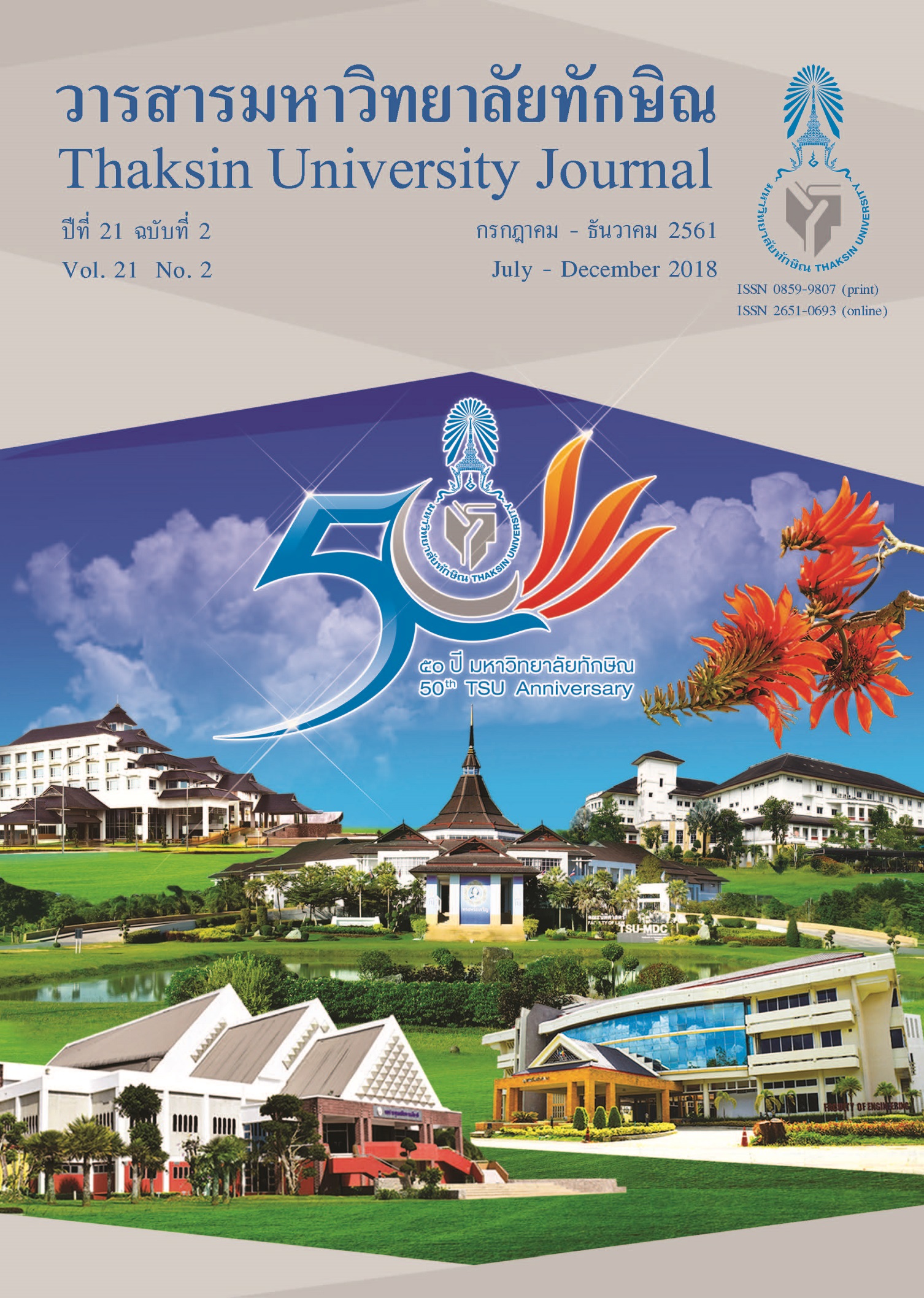Effect of Different Levels of Bacillus licheniformis Supplements in Diets on Growth Performance, Feed Utilization and Intestinal Bacteria of Hybrid Red Tilapia
Main Article Content
Abstract
Determination of optimal levels of B. licheniformis supplemented in hybrid red tilapia diet at 105, 106,
107 and 108 CFU/g and compared to the control diet was investigated. The results found that growth performance and feed utilization after the fish fed supplemented B. licheniformis diet at a concentration level of 105 CFU/g was better than other concentrations. The fish intestine microbial population was determined by DGGE (Denaturing Gradient Gel Electrophoresis) technique founded the supplementation B. licheniformis at different concentrations can result in changes in the microflora population in intestinal fish B. licheniformis at a concentration level of 105 CFU/g promoted growth performance and feed utilization. This suggests that supplementation B. licheniformis in hybrid red tilapia fish feed promotes growth of the fish in the aquaculture industry.
Article Details

This work is licensed under a Creative Commons Attribution-NonCommercial-NoDerivatives 4.0 International License.
References
Pathumthani Fisheries Test and Research Center Aquatic Animal Genetics Research and Development
Institute 1-47.
[2] Middlemiss, K.L., Daniels, C.L., Urbina, M.A. and Wilson, R.W. (2015). “Combined Effects of UV Irradiation,
Ozonation, and the Probiotic Bacillus spp. on Growth, Survival and General Fitness in European
Lobster (Homarus gammarus)”, Aquaculture. 444, 99-107.
[3] Lee, S., Lee, J., Jin, Y.I., Jeong, J.C., Chang, Y.H., Lee, Y., Jeong, Y. and Kim, M. (2017). “Probiotic
Characteristics of Bacillus Strains Isolated from Korean Traditional Soy Sauce”, LWT - Food Science
and Technology. 79, 518-524.
[4] Meidong, R., Khotchanalekha, K., Doolgindachbaporn, S., Nagasawa, T., Nakao, M., Sakai, K. and Tongpim,
S. “Evaluation of Probiotic Bacillus aerius B81e Isolated from Healthy Hybrid Catfish on Growth,
Disease Resistance and Innate Immunity of Pla-Mong Pangasius bocourti”, Fish & Shellfish
Immunology. 73, 1-10.
[5] Aly, S.M., Abdel-Galil, A.Y., Abdel-Aziz, G.A. and Mohamed, M.F. (2008). “Studies on Bacillus subtilis
and Lactobacillus acidophilus, as Potential Probiotics, on the Immune Response and Resistance of
Tilapia Nilotica (Oreochromis niloticus) to Challenge Infections” Fish & Shellfish Immunology.
25(1), 128-136.
[6] Aly, S.M., Mohamed, M.F. and John, G. (2008). “Effect of Probiotics on the Survival, Growth and Challenge
Infection in Tilapia Nilotica (Oreochromis niloticus)”, Aquaculture Research. 39(6), 647-656.
[7] Ridha, M.T. and Azad, I.S. (2012). “Preliminary Evaluation of Growth Performance and Immune Response
of Nile Tilapia Oreochromis niloticus Supplemented with Two Putative Probiotic Bacteria”,
Aquaculture Research. 43(6), 843-852.
[8] Essa, M.A., EL- Serafy, S.S., El-Ezabi, M.M., Daboor, S.M., Esmael, N.A. and Lall, S.P. (2010). “Effect of
Different Dietary Probiotics on Growth, Feed Utilization and Digestive Enzymes Activities of Nile
Tilapia, Oreochromis niloticus”, Journal of the Arabian Aquaculture Society. 5, 143-162.
[9] Sukkasem, N. and Ruangsri, J. (2007). “Effects of Plam Kernel Cake (PKC) on Growth Performance, Blood
Components and Liver Histopathology of Sex Reversed Red Tilapia (Oreochromis niloticus)”,
Songklanakarin Journal. 29, 1283-1299.
[10] Kiriratnikom, S. and Kiriratnikom, A. (2012). “Growth, Feed Utilization, Survival and Body Composition
of Fingerlings of Slender Walking catfish, Clarias nieuhofii, Fed Diets Containing Different Protein
Levels”, Songklanakarin Journal of Science and Technology. 34, 37-43.
[11] AOAC. (1990). Official Method of Analysis AOAC. 15th ed. Washington, DC: The Association of official
Analytical Chemists.
[12] Halver, J.E. and Hardy, R.W. (2002). Fish Nutrition, 3rd ed. New York: Academic Press.
[13] Burrell, P.C., Keller, J. and Blackall, L.L. (1998). “Microbiology of a Nitrite-Oxidizing Bioreactor”, Applied
and Environmental Microbiology. 64, 1878-1883.
[14] Sanders, M.E., Morelli, L. and Tompkins, T.A. (2003). “Sporeformers as Human Probiotics: Bacillus,
Sporolactobacillus, and Brevibacillus”, Comprehensive Reviews in Food Science and Food Safety.
2, 101-110.
[15] Sonenshein, A.L., Hoch, J.A. and Losick, R. (1993). Bacillus subtilis and Other Gram-Positive Bacteria:
Biochemistry, Physiology, and Molecular Genetics. (1sted). Washington, DC: American Society
of Microbiology.
[16] Tovar, D., Zambonino, J., Cahu, C., Gatesoupe, F.J., Vázquez-Juárez, R. and Lésel, R. (2002). “Effect of
Live Yeast Incorporation in Compound Diet on Digestive Enzyme Activity in Sea Bass (Dicentrarchus
labrax) Larvae”, Aquaculture. 204, 113-123.
[17] De Schrijver, R. and Ollevier, F. (2000). “Protein Digestion in Juvenile Turbot (Scophthalmus maximus)
and Effects of Dietary Administration of Vibrio proteolyticus”, Aquaculture. 186, 107-116.
[18] Nayak, S.K. (2010). “Role of Gastrointestinal Microbiota in Fish”, Aquaculture Research. 41, 1553-1573.
[19] He, S., Zhang, Y., Xu, L., Yang, Y., Marubashi, T., Zhou, Z. and Yao, B. (2013). “Effects of Dietary Bacillus
subtilis C-3102 on the Production, Intestinal Cytokine Expression and Autochthonous Bacteria of
Hybrid Tilapia Oreochromis niloticus ×Oreochromis aureus”, Aquaculture. 412-413, 125-130.


